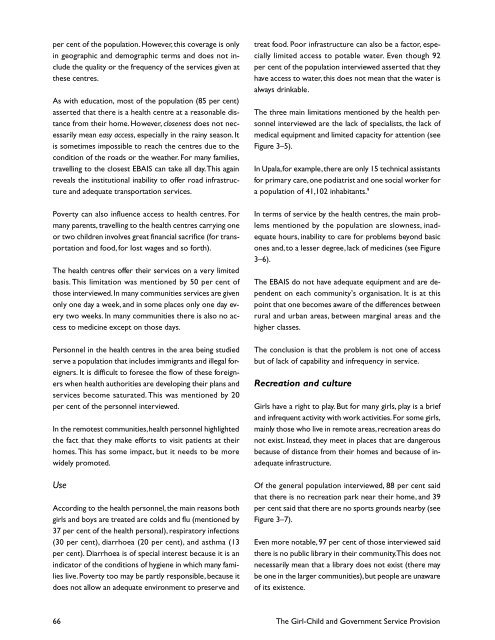The Girl-Child and Government Service Provision.pdf - Tanzania ...
The Girl-Child and Government Service Provision.pdf - Tanzania ...
The Girl-Child and Government Service Provision.pdf - Tanzania ...
- No tags were found...
Create successful ePaper yourself
Turn your PDF publications into a flip-book with our unique Google optimized e-Paper software.
per cent of the population. However, this coverage is onlyin geographic <strong>and</strong> demographic terms <strong>and</strong> does not includethe quality or the frequency of the services given atthese centres.As with education, most of the population (85 per cent)asserted that there is a health centre at a reasonable distancefrom their home. However, closeness does not necessarilymean easy access, especially in the rainy season. Itis sometimes impossible to reach the centres due to thecondition of the roads or the weather. For many families,travelling to the closest EBAIS can take all day. This againreveals the institutional inability to offer road infrastructure<strong>and</strong> adequate transportation services.Poverty can also influence access to health centres. Formany parents, travelling to the health centres carrying oneor two children involves great financial sacrifice (for transportation<strong>and</strong> food, for lost wages <strong>and</strong> so forth).<strong>The</strong> health centres offer their services on a very limitedbasis. This limitation was mentioned by 50 per cent ofthose interviewed. In many communities services are givenonly one day a week, <strong>and</strong> in some places only one day everytwo weeks. In many communities there is also no accessto medicine except on those days.Personnel in the health centres in the area being studiedserve a population that includes immigrants <strong>and</strong> illegal foreigners.It is difficult to foresee the flow of these foreignerswhen health authorities are developing their plans <strong>and</strong>services become saturated. This was mentioned by 20per cent of the personnel interviewed.In the remotest communities, health personnel highlightedthe fact that they make efforts to visit patients at theirhomes. This has some impact, but it needs to be morewidely promoted.UseAccording to the health personnel, the main reasons bothgirls <strong>and</strong> boys are treated are colds <strong>and</strong> flu (mentioned by37 per cent of the health personal), respiratory infections(30 per cent), diarrhoea (20 per cent), <strong>and</strong> asthma (13per cent). Diarrhoea is of special interest because it is anindicator of the conditions of hygiene in which many familieslive. Poverty too may be partly responsible, because itdoes not allow an adequate environment to preserve <strong>and</strong>treat food. Poor infrastructure can also be a factor, especiallylimited access to potable water. Even though 92per cent of the population interviewed asserted that theyhave access to water, this does not mean that the water isalways drinkable.<strong>The</strong> three main limitations mentioned by the health personnelinterviewed are the lack of specialists, the lack ofmedical equipment <strong>and</strong> limited capacity for attention (seeFigure 3–5).In Upala, for example, there are only 15 technical assistantsfor primary care, one podiatrist <strong>and</strong> one social worker fora population of 41,102 inhabitants. 9In terms of service by the health centres, the main problemsmentioned by the population are slowness, inadequatehours, inability to care for problems beyond basicones <strong>and</strong>, to a lesser degree, lack of medicines (see Figure3–6).<strong>The</strong> EBAIS do not have adequate equipment <strong>and</strong> are dependenton each community’s organisation. It is at thispoint that one becomes aware of the differences betweenrural <strong>and</strong> urban areas, between marginal areas <strong>and</strong> thehigher classes.<strong>The</strong> conclusion is that the problem is not one of accessbut of lack of capability <strong>and</strong> infrequency in service.Recreation <strong>and</strong> culture<strong>Girl</strong>s have a right to play. But for many girls, play is a brief<strong>and</strong> infrequent activity with work activities. For some girls,mainly those who live in remote areas, recreation areas donot exist. Instead, they meet in places that are dangerousbecause of distance from their homes <strong>and</strong> because of inadequateinfrastructure.Of the general population interviewed, 88 per cent saidthat there is no recreation park near their home, <strong>and</strong> 39per cent said that there are no sports grounds nearby (seeFigure 3–7).Even more notable, 97 per cent of those interviewed saidthere is no public library in their community. This does notnecessarily mean that a library does not exist (there maybe one in the larger communities), but people are unawareof its existence.66 <strong>The</strong> <strong>Girl</strong>-<strong>Child</strong> <strong>and</strong> <strong>Government</strong> <strong>Service</strong> <strong>Provision</strong>
















